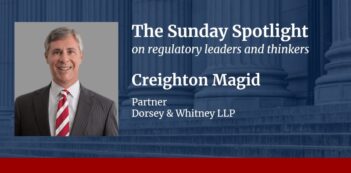
CBA methodology can respond to societal risk-aversion.
Although commonly thought of as rivals, cost-benefit analysis (CBA) and the precautionary principle (PP) actually can be reconciled.
Cost-benefit analysis (CBA) is a well-established, if fallible, methodology for ensuring that regulations enhance, rather than detract from, overall social welfare. It acts as a filter, capturing inefficient regulations while allowing efficient regulations to pass through. While many (if not all) of the elements of CBA are inherently subjective and, thus, subject to political manipulation to bias outcomes, the twin formal requirements of transparency of assumptions and replicability of calculations can provide a reasonably robust defense against outright manipulation. For example, the George W. Bush Administration’s “Clear Skies” legislative initiative was supported by a CBA that was plainly manipulated to prefer the Bush proposal over competing legislative proposals that would have required faster and deeper reductions in pollution emissions. However, a report by the Congressional Research Service exposed the flaws in the CBA for the Bush proposal, which contributed to the demise of “Clear Skies” in Congress.
The precautionary principle (PP) is more amorphous than CBA. It generally calls for a higher level of regulation or other prevention of risky market activities. A standard conception of the PP is found in the 1992 Rio Declaration on Environment and Development: “When there are threats of serious or irreversible damage, lack of full scientific certainty shall not be used as a reason for postponing cost-effective measures to prevent environmental degradation.” A more extreme version of the PP is reflected in zero-risk standards, such as the 1958 Delaney Clause (repealed in 1996), which prohibited federal approval of any food additives that posed any risk of cancer in humans or animals.
In effect, the extreme form of the PP reallocates burdens of proof relating to the manufacture, sale, and use of chemical substances. Instead of requiring complete scientific information to justify government intervention, would-be marketers of potentially risky products have to provide complete scientific information of their safety. Because science is by its very nature always underdetermined, a requirement of complete proof of safety or non-safety can never be met. Decisions about whether to regulate are necessarily based on incomplete information, which implies that an extreme version of the PP cannot be used. However, that extreme version has become something of a straw position that is often invoked by critics of the PP.
The PP and CBA are often treated as alternative, even competing, decision tools. I believe, however, that CBA is capable of incorporating a PP without sacrificing its own chief virtues of transparency and replicability. One way to do so is by specifying a higher level of risk-aversion in parameter values, i.e., by adjusting the valuations that comprise the “Ramsey equation.” Used to calculate the social discount rate under the pure-rate-of-time-preference approach (but not the alternative opportunity-cost-of-capital approach to discounting), the Ramsey equation specifies that r = ƿ + ηg, where r is the social discount rate, ƿ is the pure rate of time preference (a measure of impatience), η is the base-case coefficient of relative risk aversion (a measure of the amount of consumption society is willing to forego in the present to insure against some expected future loss), and g is the expected rate of growth in per capitaconsumption. The valuations of these elements cannot be determined objectively, but the literature suggests conventional ranges of acceptable valuations.
Among the elements that comprise the Ramsey equation, the product ηg is fully capable of mimicking a precautionary principle if values are assigned reflecting a relatively high level of risk-aversion rather than risk-neutrality. If the product ηg is low or even negative (and economists have suggested circumstances in which the value of g could even be a negative number due to a large-scale discontinuity such as an asteroid strike or catastrophic climate change), the implication would be a very low or even zero discount rate, which presumably would warrant very stringent environmental regulations because, as a rule, regulatory costs tend to be front-loaded while regulatory benefits tend to be back-loaded.
All that is needed to define a social discount rate for CBA in a way that mimics a reasonable PP is to reduce the value of the η or the g (or both) to reflect the desired level of risk-aversion, assuming that (as may not always be the case), a lower η, particularly in combination with a lower g, would signify greater social willingness to take precautions against future economic perturbations that might reduce levels of consumption.
Sir Nicholas Stern and his co-authors of The Stern Review of Climate Changearguably did exactly what I have described here when they incorporated something like a PP into their CBA or “integrated assessment model” . However, Stern derived an unconventionally low value of r mainly by selecting an unconventionally low value of ƿ. Economists criticized the Stern report for setting the discount rate paternalistically, that is, not based on observations of how people actually behave, but based on how its authors believed people should behave in light of the risks associated with climate change. Such complaints could be expected to attend any decision to deliberately adjust the social discount rate to accommodate some kind of PP.
Among the critics was Martin Weitzman, who worked on alternative approaches to constructing economic assessments of climate change that would better account for potentially catastrophic risks that did not require manipulating the elements of the Ramsey equation. Weitzman’s subsequent models demonstrated that even small risks of climate catastrophes could be so destabilizing as to completely dominate any other aspect of the analysis, including the social discount rate. For example, if climate sensitivity studies show a 5% chance of global mean temperature increases over the next 150 years of 7 degrees Celsius of greater, we could not possibly bound the negative consequences for social welfare because such great temperature variations over such a short period of time are unprecedented in the history of human civilization.
Weitzman’s modeling (which itself is not without its critics) suggests as a policy prescription relatively greater investments today to reduce the chance of potentially catastrophic increases in global mean temperatures from 5% toward zero. He describes such investments as “insurance,” which is, of course, a decidedly precautionary concept. Thus, Weitzman’s model of climate catastrophes provides another approach by which a PP can be implemented through formal CBA methods. Presumably Weitzman’s assessment of a 5% probability of potentially catastrophic climate change could equally justify a reduction in the value of g or η in setting the social discount rate.
The bottom line is that, analytically, CBA and the PP are not necessarily rivals or substitute methods for making regulatory (or deregulatory) decisions. The methodology of CBA fully allows for the incorporation of differential levels of risk-aversion based on perceived circumstances and preferences. For policies designed to deal with routine risks, CBAs can be risk-neutral, while for policies to deal with risks that are perceived to be substantially greater or intolerable (e.g., existential threats to society or irreversible impacts on critical environmental goods for which no substitutes exist), CBAs can easily build in higher levels of risk-aversion for greater precaution. The analytical tools for combining CBA and the PP already exist. And in cases where there is no consensus about the desired level of risk-aversion, conventional sensitivity analysis provides a method by which decision-makers can assess outcomes based on differential valuations.




